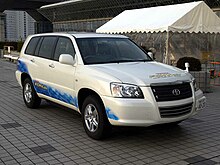Toyota FCHV
| Toyota | |
|---|---|

Toyota FCHV |
|
| FCHV | |
| Presentation year: | 2001-2008 |
| Vehicle fair: | |
| Class : | Off-road vehicle |
| Body shape : | Station wagon |
| Engine: |
Electric motor : 90 kW |
| Length: | 4735 mm |
| Width: | 1815 mm |
| Height: | 1685 mm |
| Empty weight: | 1880 kg |
| Production model: | Toyota Mirai |
The Toyota FCHV is a series of prototypes of a hydrogen - fuel cell vehicle , introduced in 2001. The successor of the FCHV-prototype built in large series Toyota Mirai .
The abbreviation “FCHV” stands for “Fuel Cell Hybrid Vehicle”, literally “Fuel Cell Hybrid Vehicle”. The hybrid must not be confused here with hybrids with an internal combustion engine. It is the technical classification as a serial hybrid . In the case of fuel cell vehicles, the drive of an electric car is also equipped with a fuel cell stack as a range extender . The vehicles not only use the accumulator as a buffer, which is charged when braking and then provides additional power for propulsion when the vehicle starts again, but the accumulator is the main energy store and can be the only power source for long distances while driving and quickly regulate load changes. This concept is used in most fuel cell vehicles today. The advantage here is that the fuel cell can work uniformly and therefore wear less.
Toyota currently knows five model generations of the FCHV, of which the first two FCHV-1 and FCHV-2 were predevelopments from 1997 and 1999 and were based on the Toyota RAV4 . The concept only attracted greater attention with the introduction of the FCHV-3 based on the Toyota Kluger V (Japanese name) or Toyota Highlander , as it is called in the USA, which is essentially ready for series production.
The FCHV-3 is the prototype of a fuel cell vehicle in which gaseous hydrogen is carried in metal hydride storage systems. The 90 kW PEM fuel cell drives an electric motor in parallel with a nickel metal hydride battery . There is also a second accumulator as a buffer for driving with return energy ("recuperation"). The vehicle was presented at the "International Symposium on Full-Cell Vehicles" in March 2001 in Tokyo.
The FCHV-4 is the prototype of a fuel cell vehicle in which gaseous hydrogen is carried in pressure tanks (250 bar). The other parameters are similar to the FCHV-3 (90 kW PEM fuel cell etc.). The vehicle was apparently developed in parallel to the FCHV-3 and presented in June 2001. This vehicle was given road approval and took part in the CaFCP for several years .
The FCHV-5 is the prototype of a fuel cell vehicle that is a natural evolution of the FCHV-4, presented in October 2001. This prototype uses high-purity gasoline as fuel. Since the fuel cell can only use hydrogen, the required hydrogen is generated from the high-purity gasoline using a reformer.
The FCHV was presented in 2002 and is the basis of a small series of fuel cell vehicles that were tested as leasing vehicles in Japan and California from 2003. The basic concept of the FCHV-4 was adopted (90 kW PEM fuel cell and 80 kW electric motor), only the pressure of the hydrogen tanks rose to 350 bar.
In 2005 an improved version was delivered to the lessee, which has a higher output (90 kW) of the electric motor. Most of the leasing vehicles delivered in 2003 were replaced by the improved version in late 2005.
At the end of September 2007 a further improved version - now with a 700 bar hydrogen tank - drove from Osaka to Tokyo without refueling, which corresponds to a distance of 350 miles or 560 km.
From 2008 the again improved version FCHV-adv was presented. These vehicles now have the 700 bar tank that can hold a total of 6 kg of hydrogen and were advertised in the press with a range of up to 830 km.
From 2010 test drives and test drives were also carried out with the Toyota FCHV-adv in Germany . The Toyota technology spokesman Dirk Breuer explained during a test drive with one of the five existing prototypes: "With this technology, the fuel cell vehicle is basically ready for series production", "A good 600 kilometers are possible with a full hydrogen tank."
The efficiency of the PEM fuel cell is around 60%, the electric motor has an output of 90 kW or 122 hp, and the torque is 260 Nm. At 1880 kg, the vehicle is only 45 kg heavier than the identical model with a combustion engine , which weighs 1835 kg. Hardly any more platinum is used in the fuel cell than in a commercially available catalytic converter for internal combustion engines.
See also
Web links
- http://www.diebrennstoffzelle.de/h2projekte/mobil/toyota_fchv.shtml
- http://www.toyota-global.com/innovation/environmental_technology/fuelcell_vehicle/ (English only)
- http://www.toyota.co.jp/en/news/07/0928.html Press release Osaka-Tokyo trip (English only)
- http://www.iwatani.co.jp/jpn/information/detail.php?idx=1030 Press release Iwatani (only Japanese)
Individual evidence
- ↑ AutoBild, June 23, 2008: Everyday Hybrid , accessed August 10, 2016
- ↑ heise.de, July 29, 2011: Test drive in the Toyota FCHV-adv , accessed on August 10, 2016
- ↑ Spiegel online, May 3, 2010: Toyota FCHV-adv: Future from the construction kit , accessed on August 10, 2016
- ↑ heise Autos, August 1, 2011: Test drive in the Toyota FCHV-adv , accessed on February 12, 2012

